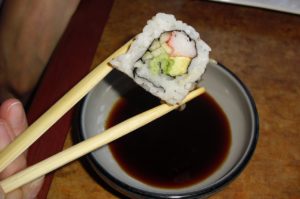A complete guide to genetically modified fish products
GMOs are present in at least 70% of grocery store products, even seafood. If you're a savvy shopper, you may wonder how a seafood product could have GMOs. Don't fish come directly from the ocean?
Unfortunately, it is not that simple.
Understanding how to identify hidden genetically modified ingredients in seafood is essential for the natural shopper.
Common GMO ingredients in seafood products

Many common fish products contain added ingredients, which may be derived from GMOs. California roll lovers in particular should be aware of surimi's GMO ingredients, as traditional varieties often contain genetically modified soy, sugar and other additives. When comparing Non-GMO Project Verified surimi to conventional options, the difference in high-risk GMO ingredients becomes apparent.
| Example 1: Non-GMO Project Verified Surimi | Example 2: Surimi that is not Verified |
|---|---|
| ALASKA POLLOCK, WATER, PEA STARCH, CANE SUGAR, SEA SALT, NATURAL FLAVOR, POTASSIUM CHLORIDE, COLOR ADDED (LYCOPENE FROM TOMATOES) | SURIMI 40% (FISH PROTEIN, SUGAR, STABILIZER: POLYPHOSPHATE), WATER, POTATO STARCH, EGG WHITE, RAPESEED OIL, SALT, SUGAR, FLAVORINGS (CONTAINS CRUSTACEANS AND MOLLUSKS), SOY, STABILIZER: CARRAGEENAN, MONOSODIUM GLUTAMATE, FOOD COLORINGS: TITANIUM DIOXIDE, PAPRIKA OLEORESIN, CARMINE |
How do the two products measure up?
The first example meets the requirements of the Non-GMO Project Standard, North America's most rigorous certification for GMO avoidance. The manufacturer chose ingredients from non-GMO sources instead of more common GMO options.
- Pea starch — Pea starch can be a non-GMO alternative to corn starches made from GMOs, according to industry experts.
- Cane sugar — Cane sugar offers a non-GMO alternative to sugar made from GMO sugar beets.
The second example contains several ingredients that may be derived from GMOs, according to USDA data.
- Fish protein — Farmed fish often receive GMO feed, making this ingredient a GMO risk.
- Sugar — 99% of US-grown sugar beets are genetically modified.
- Potato starch — Potatoes were added to the GMO High-Risk List in 2018 because of GMO potatoes developed by JR Simplot.
- Egg whites — Chicken feed often contains corn, soy and canola meal, which frequently come from GMO crops.
- Rapeseed oil — 95% of the rapeseed, also known as canola, grown in the US is genetically modified.
- Soy — 96% of the soy grown in the US is genetically modified.
Read about high-risk GMO ingredients
Explore why potatoes joined the High-Risk List
These are the obvious GMO risks, but they aren't the only ones. Other ingredients, such as flavorings and coloring, could also come from GMOs. While the fish used as the primary ingredient in surimi does not appear to be GMO, we've seen several varieties of genetically engineered fish entering commercial markets over the past decade.
AquaAdvantage salmon: The first genetically modified fish for human consumption
Fast-growing AquaAdvantage salmon was engineered using genetic material from three different types of fish: Atlantic salmon, Chinook salmon and the eel-like ocean pout. It was the world's first genetically modified animal approved for human consumption.
AquaAdvantage salmon was farmed in land-based facilities, first in Prince Edward Island, Canada, and later in Albany, Indiana. It was sold in Canada beginning in 2017 and entered US markets in 2021.
However, market availability doesn't indicate acceptance. AquaAdvantage salmon was not ultimately a market success, and the company behind the GMO fish ceased production and shuttered facilities in 2024.
Gene-edited seafood: GMO fish enters the market in Japan
A Japanese start-up developed three genetically engineered fish in collaboration with various academic and governmental institutions. All three GMO fish are the product of genome-editing techniques to promote faster growth. Unlike stricter regulations for transgenic GMOs, gene-editing approval pathways in Japan are streamlined to allow faster market introduction.
Japanese gene-edited seafood includes modified red sea bream and tiger puffer fish, developed through genome-editing techniques. A third gene-edited fish, a Japanese Flounder, was announced in October 2023, but does not appear to be publicly available at this time. You can read more about these gene-edited fish in our New GMO Alert.
Look for the Butterfly of the sea
The Non-GMO Project Standard is North America's most rigorous certification for GMO avoidance. In fact, the Butterfly label represents one of the only certifications that evaluates the feed of the animal-derived products it verifies.
Non-GMO seafood shopping requires attention to both the main fish ingredient and added components that might contain genetically modified organisms. Or, simply look for the Butterfly when shopping for seafood to ensure the products you buy meet the highest standard for GMO avoidance.
With more GMOs poised to enter the market, monitoring the latest developments is increasingly important for consumer transparency. The Non-GMO Project research team continues to track the development of GMO seafood products, including several lab-grown and cell-cultured fish and shellfish that may be produced through genetic engineering. Sign up for the New GMO Alerts to stay up-to-date.
FAQ
What seafood products typically contain GMOs?
Multi-ingredient products may contain GMOs as added ingredients, such as colors, flavors or other additives derived from GMO corn, soy or canola. The only GMO fish available in Canada and the US, AquaAdvantage salmon, is no longer in production, however there are several gene-edited fish available in Japan.
How can I tell if a seafood product contains GMOs?
In the US, some products made with GMOs must be labeled under the USDA's National Bioengineered Food Disclosure Standard. However, the bioengineered (BE) food labeling law leaves out many products of genetic engineering. The best way to avoid GMOs is to look for the Butterfly. Find out more about the bioengineered food labeling law.
Is farmed salmon genetically modified?
In Canada and the US, "farming" facilities for genetically modified salmon closed in 2024.
